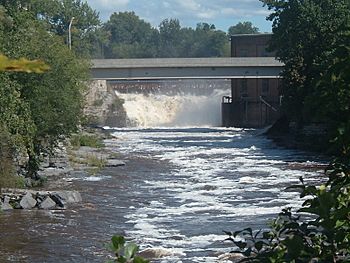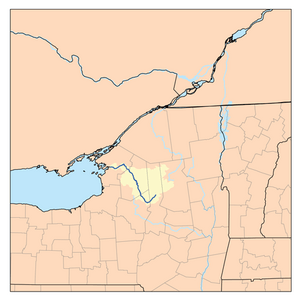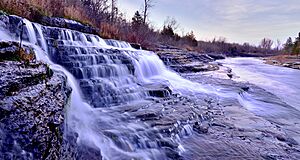Black River (New York) facts for kids
Quick facts for kids Black River |
|
|---|---|

The Black River's Great Falls, Watertown, New York.
|
|

A map of the Black River watershed
|
|
| Country | United States |
| State | New York |
| Physical characteristics | |
| Main source | North Lake Herkimer County, New York, Adirondack Mountains 1,850 ft (560 m) 43°31′19″N 74°56′53″W / 43.52194°N 74.94806°W |
| River mouth | Lake Ontario Dexter, Jefferson County 246 ft (75 m) 43°59′39″N 76°03′54″W / 43.99417°N 76.06500°W |
| Length | 125 mi (201 km) |
| Basin features | |
| Progression | Lake Ontario→ Saint Lawrence River→ Gulf of Saint Lawrence |
| River system | Lake Ontario drainage basin |
| Basin size | 1,920 sq mi (5,000 km2) |
| Tributaries |
|
The Black River is a 125-mile-long river in New York, USA. It flows into the eastern part of Lake Ontario. Its name might come from the dark color of its water in some places. This color is caused by natural tannic acid from plants. The river flows mostly northwest. It separates the Adirondack Mountains from the Tug Hill region.
Contents
Where Does the Black River Flow?
The Black River starts at North Lake. This lake is in the Adirondack Mountains foothills, in Herkimer County. It's about 25 miles east of Boonville. The river first flows west into Oneida County. Then it turns north, passing Forestport and Boonville. It then enters Lewis County.
At Lyons Falls, the Moose River joins it from the east. Just below this point, the river drops 70 feet over a cliff. This creates a beautiful waterfall. Near Glenfield, other smaller rivers join the Black River. These include Otter Creek and the Independence River.
Further north, the river flows past Lowville. It then receives the Beaver River from the east. The Deer River also joins it. This is its main tributary from the west.
Above Carthage, the river briefly forms the border between Lewis and Jefferson Counties. It then enters Jefferson County completely. Here, it turns sharply west towards Lake Ontario. It flows past Great Bend, Black River, and Watertown. Below Watertown, the river enters a deep canyon. This part is famous for its exciting rapids.
The Black River finally reaches Lake Ontario in the village of Dexter. This is about 10 miles west of Watertown. It empties into Black River Bay and Marsh. These areas are part of the "Golden Crescent." For its last few miles, the river forms the boundary between the towns of Brownville and Hounsfield.
Dams and Power
There are at least 17 dams along the Black River. Eight dams are in the upper part, above Lyons Falls. Nine more are located below Watertown. The river's upper and lower sections have a steep slope. This made them perfect for building mills long ago. Later, these dams were used to create hydroelectricity. This is power made from moving water.
The middle 40 miles of the river are very flat. They are not suitable for building dams to make power. The three highest dams create large lakes. These are North Lake, Kayuta Lake, and Forestport Reservoir. Other dams on the river are "run-of-the-river" dams. This means they don't store much water. They rely on the river's natural flow to make electricity.
Fun Activities on the River
The Black River is a great place for fishing. You can find many types of fish here. These include trout, salmon, bass, and pike. Salmon is a very popular fish to catch.
Whitewater rafting and kayaking are also popular. People especially enjoy the Black River Canyon. This canyon starts in Watertown and ends in Brownville. The Black River Canyon is special because it has good water levels all summer. This makes it a reliable spot for exciting whitewater adventures.
Protecting the River
Some streams and lakes in the Black River area have been affected by acid rain. This pollution can harm the water and its living things. Also, high levels of mercury have been found in some fish. Because of this, people are advised to limit how much fish they eat from certain areas.
In 2005, the Black River faced a big challenge. A large amount of farm waste accidentally spilled into the river. This happened near Lowville. The spill caused harm to the river's ecosystem. Sadly, many fish died because of the pollution.
However, action was taken to fix the problem. By 2006, a settlement was reached. The farm responsible for the spill had to pay $2.2 million. This money helps with cleanup efforts and protecting the river. It shows how important it is to keep our rivers clean and safe.
Rivers That Join the Black River
|
|



